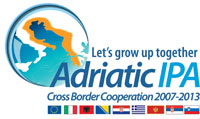
| Address L."Isa Boletini", Rruga Vlore-Skele, Kati III, Prane Bankes IntesaSanPaolo Vlore, Albania |
Contacts: Tel/Fax +355 33 403 237 E-mail: Questo indirizzo email è protetto dagli spambots. È necessario abilitare JavaScript per vederlo.%CA">Questo indirizzo email è protetto dagli spambots. È necessario abilitare JavaScript per vederlo. Web page: www.auleda.org.al |
Contact person: Mrs. Mirela Koci, Executive Director Tel: +355 692 075 550; E-mail: Questo indirizzo email è protetto dagli spambots. È necessario abilitare JavaScript per vederlo. |
Brief description
AULEDA - Local Economic Development Agency, is a nonprofit organization established in August 2003.
Territory where it operates:
This agency serves about 300,000 residents of Vlora County, and operates in an area of 2706 km².
Vlora Region includes seven municipalities and 19 communes, respectively : Vlora, Orikum, Saranda, Delvina, Himara Selenica, Konispol and communes: Center, Novosele, Shushice, Armen, Vllahine, Sevaster, Kote, Brataj, Hore-Varnisht, Finiq, Mesopotam, Vergo, Lukove, Livadhja, Markat, Xare, Dhiver, Ksamil, Aliko.
Mission:
Its mission is to provide services and execute initiatives and projects for social, economic, cultural and environmental development of the region of Vlora to spread the Curtural view integration and consolidation of resources, skills and competencies according to the principles of human development.
Objectives:
- Strengthening and Promoting a sustainable and comprehensive development of Vlora District.
- Contribution for the establishment and strengthening of strategies for planning at local level.
- Provide support to regional population, local administration and civil society to promote capacity and increasing of the performance.
Priority Sectors:
- Sustainable Tourism Development
- Agro food.
- Fishing.
- Handicraft.
- ICT
Brief description of the territory
DESCRIPTION
Vlora Region is one of the 12 regions of Albania, established as a local governmental unit on November 30th, 2000. The Region includes the districts of Vlora, Saranda and Delvina. Every district, includes one or more Municipalities and a number of Communes, for a total of 7 Municipalities and 19 Communes. The regional capital is Vlora, a large industrial, commercial and communication centre. The estimated population of the Region is 211.734 inhabitants (INSTAT, 2009), on a 2.706 square kilometers surface. Vlora Region is situated in the south -western part of Albania extended mostly on the Ionian coastline. Vlora is the Region with the longest coastline in the country. Its geographic characteristics are the main potentialities for tourism and local development. The Region has a coastline of 144 km, which is home to beautiful sandy beaches. The shore starts in the southern part of the city of Vlora and meanders to the most southern point of the Greek border, including the Karaburun Peninsula and the Albanian Riviera. The Region is mainly mountainous and hilly. Its meadows and valleys enable the local population to make their living through the agricultural and livestock production. The area constitutes a mosaic of historical and cultural traditions offering a variety of habitats and important environmental values.
GEOGRAPHIC DESCRIPTION
Vlorë County is located in the south of Albania and forms the Albanian Riviera. The southeastern part of the county borders Greece. The county has a total area of 2,706 km2 (1,044.8 sq mi). Albanian Riviera is a coastal area in the County of Vlorë running along the Ionian Sea under the Ceraunian Mountains in Southern Albania. O lot of beautiful place are in Vlora Region like Llogara National Park, continues down along the coast through the villages of Borsh, Himara, Qeparo, Piqeras, and ends at Lukovë. Other sources mark Sarandë or Tongo Island as the end point, and Vlorë or Karaburun Peninsula as the start point.. The area is a major nightlife, eco-tourist, and elite retreat destination in Albania. The region features traditional Mediterranean villages, ancient castles, and Orthodox churches. In fact, the landscape alternates between mountain passes, turquoise beaches, underwater fauna, caves, and orange, lemon and olive plantations. In 48 BC during his pursuit of Pompey, Julius Caesar set foot and rested his legion at Palase. He continued onto Llogara Pass in a place later named Caesar's Pass. As part of the regional master plan, the World Bank and other institutions are financing local infrastructure projects, including the renovation of roofs and facades of traditional houses overlooking the Riviera.
Administrative divisions
|
District |
Capital |
Area (km) |
Municipalities / Communnes |
||
|
10,810 |
348 |
Delvinë, Finiq, Mesopotam, Vergo |
|||
|
35,201 |
749 |
Aliko, Dhivër, Konispol, Ksamil, Livadhja,Lukovë, Marka, Sarandë, Xarrë |
|||
|
147,411 |
1,609 |
Armen, Brataj, Himarë, Horë-Vranisht, Kotë, Novoselë, Orikum, Qendër, Selenicë, Sevaster, Shushicë, Vllahinë, Vlorë |
|||
Cultural heritage
Vlora Region is a repository of interesting cultural traditions, which are the expression of a remarkable ethno-cultural area, called “Laberi”. These traditions can be found in many fields: architecture, folklore, music, handicraft, gastronomy, etc. The Region maintains the tradition of Iso-Polyphony, classified by UNESCO in 2005 as a masterpiece of the oral and intangible heritage of humanity. Iso-polyphony is a sophisticated form of group singing, derived from Byzantine church music, and performed mostly by men. Nowadays, this tradition is adversely affected by poverty, absence of legal protection, lack of financial support for practitioners, and emigration of young people from rural areas. The Region is also well known for its crafts, including traditional costumes of the different communes, handmade carpets and tapestries, woolen covers, knitting, embroidery, felt processing, work tools, and musical instruments. Traditionally, brides prepared their own handmade dowry and in some villages this tradition is still practiced. For this reason in most village houses original and handmade traditional costumes, carpets, and embroidery can be found. Presently, there are very few places where tourists can view or purchase such handicrafts. There is great potential for reviving a few ethnographic museums and developing commercial activities where tourists can both observe the process of producing handicraft and purchase the products. In the city of Vlora, there are three functioning museums , the Museum of National Independence, the Museum of Historic Relics (or History Museum) and the Ethnographic Museum. Each of the latter presents different aspects of the regional history. The fourth museum in the Region is the Archaeological Museum of Butrint, which contains the archaeological material discovered in the site.
Economy of Vlora Region
The city of Vlorë remains a major seaport and commercial centre, with a significant fishingand industrial sector. The county produces petroleum, natural gas, bitumen and salt.
Vlorë County has grown in importance in agriculture with very large-scale planting of olive and fruit trees, and the city has become center of the food processing, oil and bitumen export industries. The county is mainly agricultural and pastoral, producing oats, maize, cotton, olive oil, cattle, sheep, skins, hides and butter. These commodities are exported.
Tourism has become a major industry in recent years, with many hotels, recreational centers, and vast beaches. The Region is characterized by diverse economic conditions that are directly connected to the different levels of development. The difference in the quality of life between coastal urban areas and rural areas (mainly situated in mountains or in river valleys) is noticeable and it is the cause of several social and economic issues. This situation is strictly connected with the role that “beach and sand” tourism has played so far in local development.


















